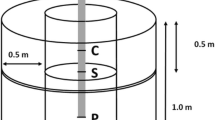Abstract
Four clones of Populus were planted in replicated monoclonal plots near Olympia, WA, to evaluate their suitability for use in short-rotation culture. All clones were easily established and had minimal problems from damaging agents during the first five years. Observed differences among clones in pattern and amount of growth appeared to be associated with differences in number and density of buds, sylleptic branching, and phenology. In addition, differences in drought tolerance and stockability may also have influenced clonal differences in annual growth and stand productivity. Individual tree growth was limited by the dense 1.0-m spacing, but the best-growing clones averaged 13 to 16 m tall, 7 to 9 cm in breast-high diameter (1.3 m), and produced stand basal areas exceeding 38 m2ha-1at 8 years. Mortality was negligible for 7 years, after which various combined effects of competition, stem borer damage (Cryptorhyncus lapathi), and a severe windstorm caused mortality ranging from 18 to 36% in the three fastest growing clones.
Similar content being viewed by others
References
Associated Forest Products Consultants, Inc. 1990. A study of marketing prospects for hybrid cottonwood grown in southwest Washington by private landowners. 81 pp.
DeBell, D. S., Clendenen, G.W. and Zasada, J.C. 1993. Growing Populusbiomass: comparison of woodgrass versus wider-spaced short-rotation systems. Biomass and Bioenergy 4(5): 305–313.
DeBell, D. S., Harms, W. R. and Whitesell, C. D. 1989. Stockability: a major factor in productivity differences between Pinus taedaplantations in Hawaii and the southeastern United States. Forest Science 35(3): 708–719.
DeBell, D. S., Clendenen, G. W., Harrington, C. A. and Zasada, J. C. 1996. Tree growth and stand development in short-rotation Populusplantings: 7-year results for two clones at three spacings. Biomass and Bioenergy 11(4): in press.
Dula, J. C. 1984. Woodgrass production for energy application. InProceedings of the 2nd Technical Review Meeting, Energy from Biomass: Building on a Generic Technology Base. 185 pp. Argonne National Laboratory, Wilsonville, OR, 23–25 April 1984.
Heilman, P. E., and Stettler, R. F. 1985. Genetic variation and productivity of Populus trichocarpaand its hybrids. II. Biomass production in a 4-year plantation. Canadian Journal of Forest Research 15: 855–859.
Heilman, P. E., Stettler, R. F., Hanley, D. P. and Carkner, R.W. 1991. High yield hybrid poplar plantations in the Pacific Northwest. PNW Ext. Bull. No. 356. WSU Coop. Extension, Puyallup, WA. 32 p.
Hinckley, T. M., Braatne, J., Ceulemans, R., Clum, P., Dunlap, J., Newman, D., Smit, B., Scarascia-Mugnozza, G. and van Volkenburgh, E. 1992. 1. Growth dynamics and canopy structure. pp. 1–34 In Mitchell, C. P., Ford-Robertson, J. B. and Sennerby-Forsse, L. (Eds). Ecophysiology of Short Rotation Forest Crops. Elsevier Applied Science Publishers Ltd., London. 308 p.
Miner, C.L. 1990. Changing times for hardwoods, pp. 1–6 inForestry ResearchWest. December 1990. USDA Forest Service.
Quinsey, S., Stettler, R., Heilman, P., Delany, D., Fenn, R., Ager, A. and Glackin, P. 1991. Clone register. University of Washington/Washington State University Poplar Research Program. College of Forest Resources, University of Washington, Seattle. 115 pp.
Radwan, M. A., Kraft, J. M. and DeBell, D. S. 1987. Bud characteristics of unrooted stem cuttings affect establishment success of cottonwood. USDA Forest Service, Pacific Northwest Research Station, Research Note PNW-RN-461. 8 p.
Ranney, J. W., Wright, L. L. and Layton, P. A. 1987. Hardwood energy crops: the technology of intensive culture. Journal of Forestry 85(9): 17–28.
Scarascia-Mugnozza, G. 1991. Physiological and morphological determinants of yield in intensively-cultured poplars (Populusspp.). Unpublished Ph.D. dissertation, University of Washington, Seattle, WA. 189 p.
Schulte, P. J., Hinckley, T. M. and Stettler, R. F. 1987. Stomatal response of Populusto leaf water potential. Canadian Journal of Botany 65: 255–260.
Weber, J. C., Stettler, R. F. and Heilman, P. E. 1985. Genetic variation and productivity of Populus trichocarpaand its hybrids: I. Morphology and phenology of fifty native clones. Canadian Journal of Forest Research 15: 384–388.
Zimmerman, M. H., and Brown, C. L. 1971. Trees – Structure and Function. Springer-Verlag, New York. 336 p.
Author information
Authors and Affiliations
Rights and permissions
About this article
Cite this article
DEBELL, D.S., HARRINGTON, C.A., CLENDENEN, G.W. et al. Tree growth and stand development of four Populus clones in large monoclonal plots. New Forests 14, 1–18 (1997). https://doi.org/10.1023/A:1006501229936
Issue Date:
DOI: https://doi.org/10.1023/A:1006501229936




